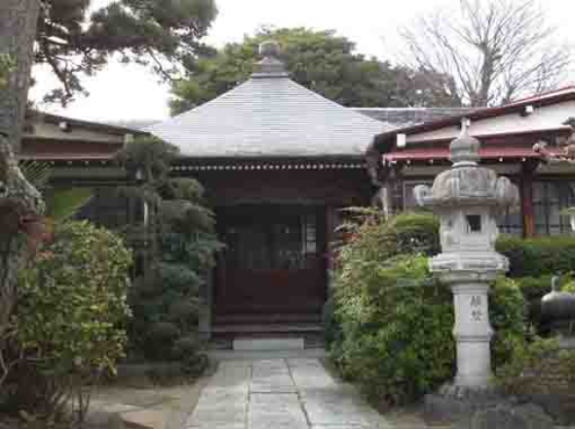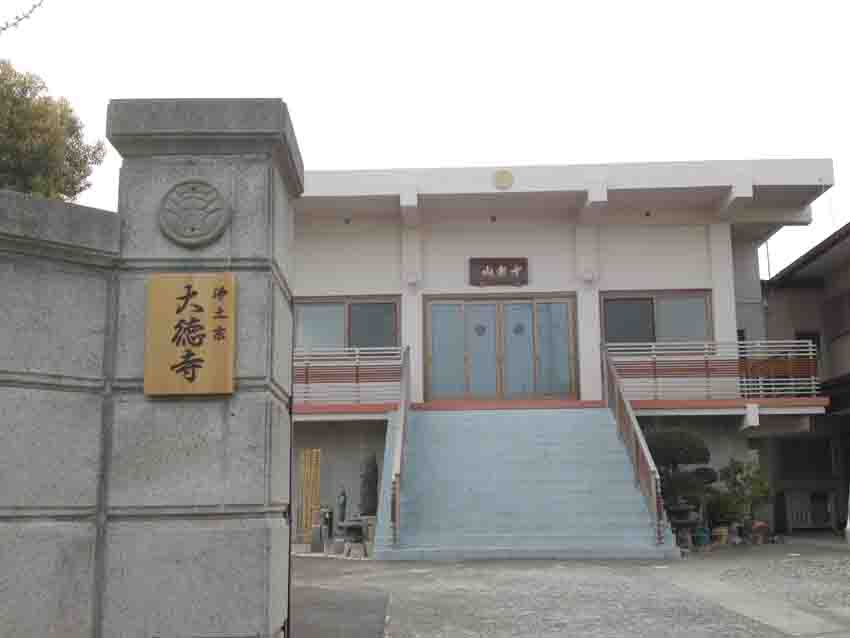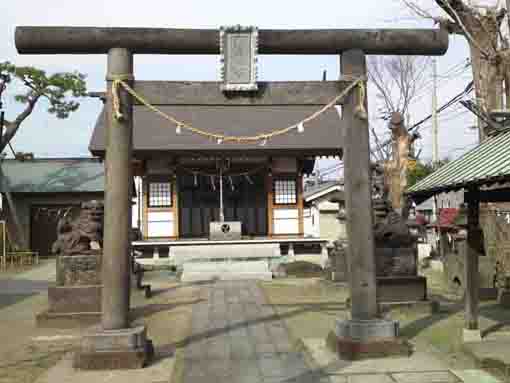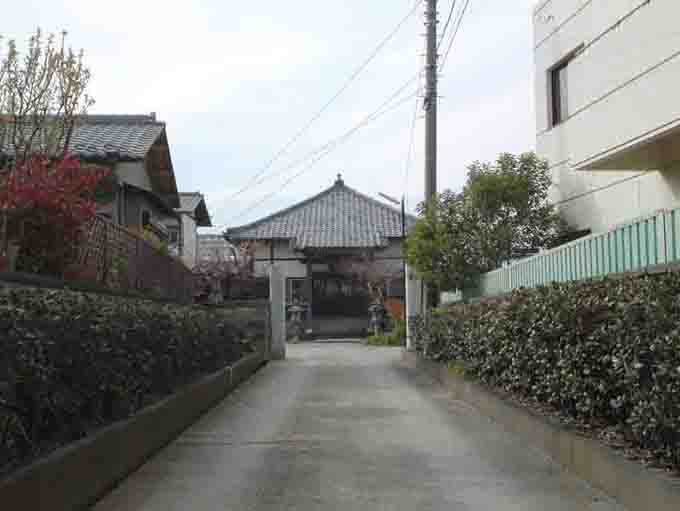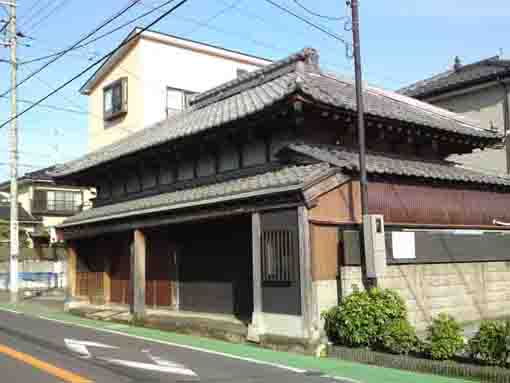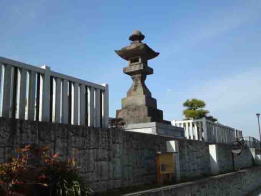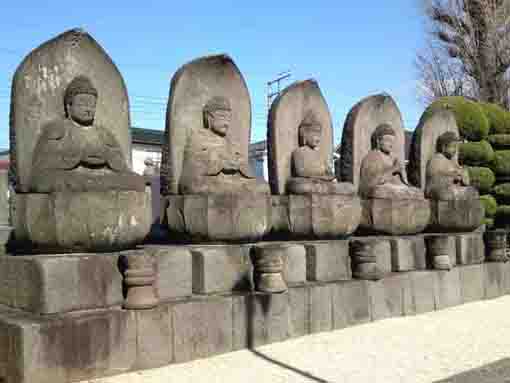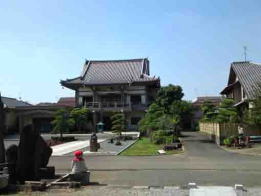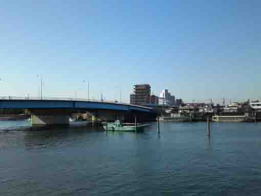Nakayama is in between Narita And Haneda International Airport
<クッキーについての同意並び欧州居住者向けプライバシーポリシー>
中山・下総・散歩道
Enmyoin Temple in Gyotoku | The 23th Temple
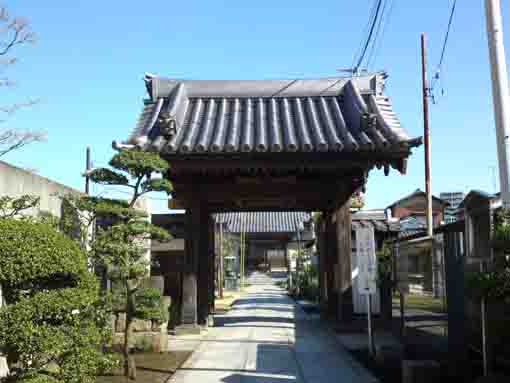
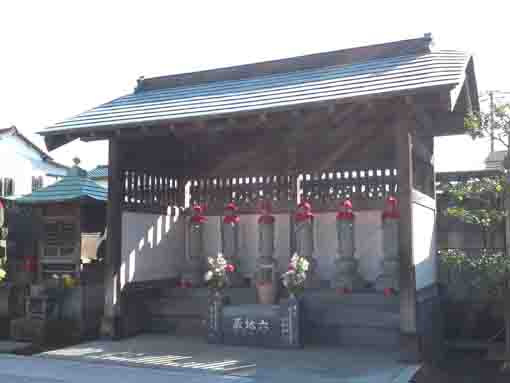
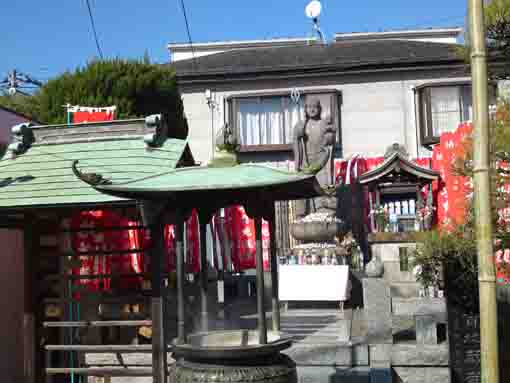
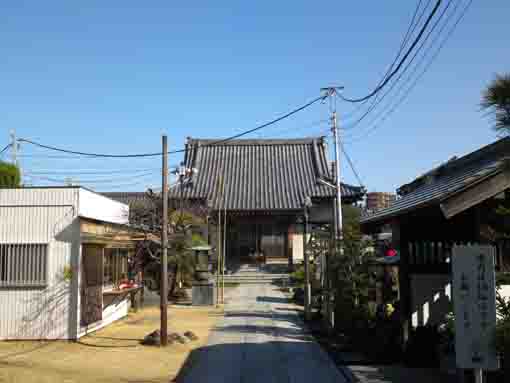
Getting off the subway at Gyotoku Station and going to Edogwa river, there is a wonderful temple suitably called the 23th temple of the 33 Pilgrimage in Gyotoku and Urayasu.
On the middle of the approach road, an old wooden gate stands, and there are a statue of Jizo for children's health and safe and 6 jizo statues for people's happiness standing in the temple. Moreover, Edo Meisho Zue (a guide book introducing Edo in Edo period) describes a small shrine dedicating Benzaiten.
Enmyoin Temple is exactly the 23rd temple of the 33 Pilgrimage in Gytoku and Urayasu. Why don't you visit Enmyoin Temple in Gyotoku.
Suisosan Enmyoin Temple
The History of Suisosan Enmyoin Temple
It is said that Kakugen a priest belonged to Shingon sect built Enmyoin Temple in 1560.Even though most buildings in Enmyoin Temple has lost several times by disasters such as fires and tsunamis, the main gate (Sanmon Gate) and a fire bell only exist.
The main gate was built in 1738 and it was renovated in 1992. This gate is the oldest building in Gyotoku area that the construction date is exactly recorded.
The fire bell was made by Yukai in 1788. On its surface, the area name '下総國本湊村 (Honninato village in Shimousa province)' and the temple's name '水奏密山圓明教院 (Suisomitsusan Emnyoin)' are carved.
The main hall was rebuilt in 1981.
The Events and Landmarks in Suisosan Enmyoin Temple
On the left side of the main gate, there is a Benzaiten shrine that there are no records who and when built it, but it was described in an old map of Edo that the Benzaiten in Honminato village is one of 3 Bentens in Katsushika.A Jizo for raising children standing left side of the approach road was built in 1977 by the 18th chief priest of this temple to pray for children's sound health and traffic safety.
The 6 jizos standing right side of the approach was built in 1999 by Denichi Yajima, the leading supporter to pray for the all people's happiness.
水奏山圓明院門前案内板より
The Main Gate (Sanmon Gate) of Suisosan Enmyoin Temple
The Sanmon Gate of Enmyoin Temple
This temple named Suisosan Enmyoin was built in by Kakugen in 1560 and it has been kept on praying for people's happiness for 430 years.According to some old documents, the Sanmon Gate (the main gate) of this temple was built in June 1738 and it was renovated and changed from the thatched to the tiled roof in the middle of Meiji era. Over 100 years had passed after the renovation, the parts above the rafters of the gate had been corroded very much, so supporters and followers had examined and talked several times since the early spring in 1991, and they asked to an architecture to check it. As a result, they decided to rebuilt the gate as the commemorative project of the 850th anniversary of Kokyodaishi since the gate would fell down soon. Then a committee to rebuild the Sanmon Gate was formed and the donating funds were enough collected. In May 1992, the committee asked Suiundo a constraction company and the renovation has started.
During dismantling the gate, the committee researched it with members of the Board of Education of Ichikawa city and the Japanese Association for conservation of Architectural Monuments and they found its history and features.
The Sanmon Gate was built by the chief priest Kakueibo in June 1738, the carpenter was Shozaemon Kojima, Chuhachi Oka and Risuke from Satte in Musashi province. The gate was a type of Yonkyakumon gate (a gate has four pillars) and it was constructed of zelkova wood. The gate is lacquared, and the patterns of pictures and sculptures on it are the height of fashion at Edo period. And also it is a very valuable gate as its carpenters’ name were recorded and it shows shrine carpenters activities and techniques at that time well. This Sanmon Gate is the oldest gate that the exact period of construction was clear.
The renovation was safely completed for seven months.
December 10th of 1992.
Gassho by The 18th Chief Preist of Enmyoin Temple
The committee to renovate the Sanmon Gate
水奏山圓明院門前案内板より
(一部割愛)
Benzaiten Shrine in Suisosan Enmeiin Temple
Benzaiten Shrine in Enmeiin Temple
Katsushikaki (a local guide book published in Edo period) said that the Benzaiten in this temple was built by the venerable Junyo since he saw a dream that had told him to build a shrine dedicating Benzaiten. Then he built it in 1718 on Mt. Benzaiten along Edogawa River, and it moved in this temple later. The Benzaiten in this temple was the same deity dedicated in Itsukushima Jinaja Shrine in Miyajima (Hiroshima) or Benzaiten in Enoshima (Kanagawa).And according to the signboard beside the main gate of this temple, onthe left side of the main gate, there is a Benzaiten shrine that there are no records who and when built it, but it was described in an old map of Edo that the Benzaiten in Honminato village is one of 3 Bentens in Katsushika.
抜粋・引用および参考
水奏山圓明院門前案内板
水奏山圓明院山門脇案内板
市川市ホームページ
江戸名所図会6 ちくま学芸文庫
房総叢書 紀元二千六百年記念 第8卷葛飾紀
房総叢書 紀元二千六百年記念 第6卷葛飾誌略
The Temples of the 33 Pilgrimage in Gyotoku & Urayasu
The list of the temples of the 33 Pilgrimages in Gyotoku and Urayasu
- 01 Tokuganji : 5-22 Hongyotoku Ichikawa-shi
- 02 Fukusenji :2-7 Futamata Ichikawa-shi
- 03 Choshoji : 8-5 Hongyotoku Ichikawa-shi
- 04 Jishoin : 1-10 Hongyotoku Ichikawa-shi
- 05 Daitokuji : 5-13 Shimonijuku Ichikawa-shi
- 06 Jorinji (abandoned) : around Kawara Ichikawa-shi
- 07 Shogenji : 3-6 Kawara Ichikawa-shi
- 08 Yofukuin : 5-16 Kawara Ichikawa-shi
- 09 Ryugonji (Sorinji) : 3-10-2 Tokagi Ichikawa-shi
- 10 Fukuoji (Sorinji) : 3-10-2 Tokagi Ichikawa-shi
- 11 Ryogokuji : 2-16-4 Koya Ichikawa-shi
- 12 Anyoji : 2-16-35 Koya Ichikawa-shi
- 13 Hosenji : 7-22 Hongyotoku Ichikawa-shi
- 14 Hozenji : 1-25 Honshio Ichikawa-shi
- 15 Jokanji : 23-24 Hongyotoku Ichikawa-shi
- 16 Shingyoji (Kyoshinji) : 38-18 Hongyotoku Ichikawa-shi
- 17 Kyozenji (Kyoshinji) : 38-18 Hongyotoku Ichikawa-shi
- 18 Hoshoji (abandoned) : now brought into 19 Tokuzoji
- 19 Tokuzoji : 8-10 Sekigashima Ichikawa-shi
- 20 Seiganji : 4-8 Oshikiri Ichikawa-shi
- 21 Korinji : 12-20 Oshikiri Ichikawa-shi
- 22 Hodenji : 7-1 Minato Ichikawa-shi
- 23 Enmyoin : 11-21 Minato Ichikawa-shi
- 24 Zenshoji : 18-20 Minato Ichikawa-shi
- 25 Genshinji : 1-16-26 Katori Ichikawa-shi
- 26 Ryozenji : 2-12-18 Ainokawa Ichikawa-shi
- 27 Shinseiji : 1-9-1 Arai Ichiakawa-shi
- 28 Enmeiji : 1-9-2 Arai Ichikawa-shi
- 29 Zenpukuji : 26-27 Todaijima Urayasu-shi
- 30 Kezoin : 3-10-3 Nekozane Urayasu-shi
- 31 Togakuji : 2-4-27 Horie Urayasu-shi
- 32 Hojoin : 4-14-1 Horie Urayasu-shi
- 33 Dairenji : 4-14-2 Horie Urayasu-shi
- extra Fujiwara Kannondo Hall 2-234 Fujiwara-cho Funabashi-shi
* Please ask some specific information in each temple.
Why don't you visit the 33 Temples on this movie?
This movie is a slideshow created by some pictures of the temples. Why don't you watch it?
The Location and Access to Enmyoin Temple
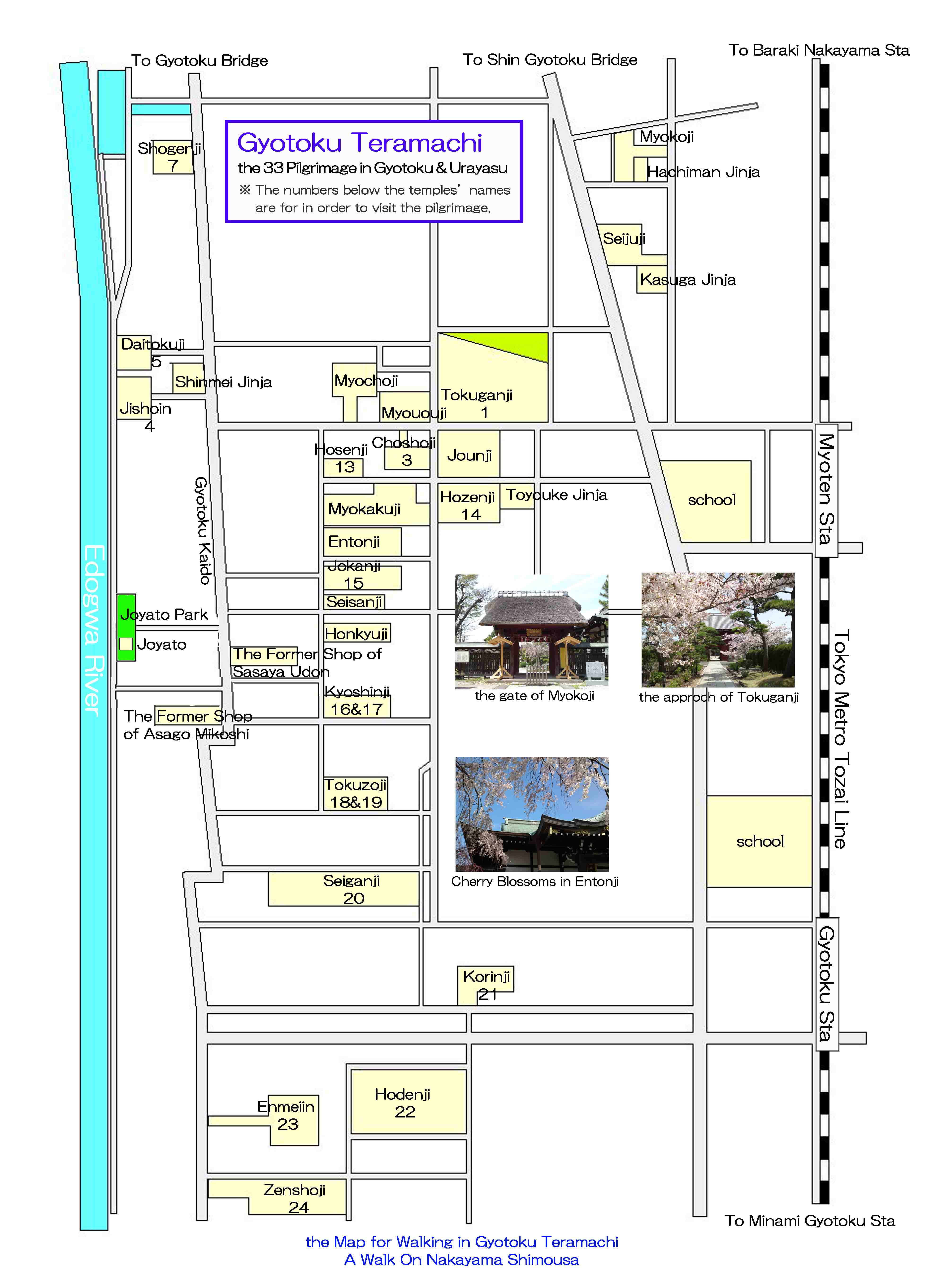
The map of the noted spots in Gyotoku Teramachi Areas
PDF of the Map of the landmarks in Gyotoku Teramachi Areas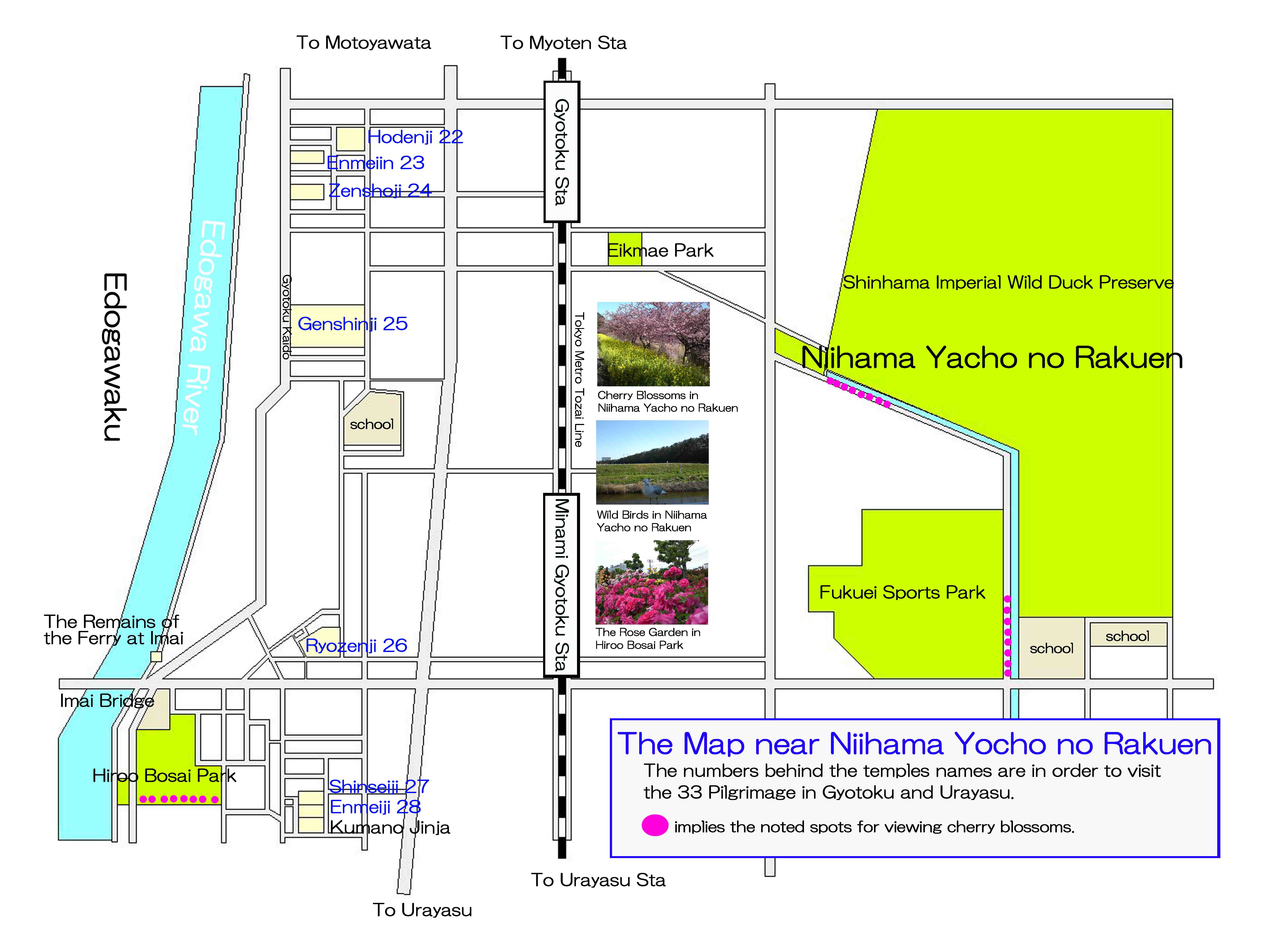
The map of the noted spots near Niihama Yacho no Rakuen
PDF of the map of the landmarks near Niihama Yacho no RakuenEnmyoin Temple
- Enmyoin Temple has a great accessibility from both Narita and Haneda International Airport.
- From Narita International Airport, take JR Sobu-express line, transfer the line at Nishi-funabashi to Tozai line of Tokyo Metro bound to Nakano or Mitaka, get off Myoden Sta. And also take Keisei-line, transfer the line at Funabashi to Sobu-Local line, and transfer the line at Nishi-funabashi to Tozai line of Tokyo Metro bound to Nakano or Mitaka, get off Gyotoku Sta. It takes minimally 60 minutes from Narita Airport.
- From Haneda International Airport, take Keikyu-line bound to Narita, transfer the line at Nihonbashi to Tozai line of Tokyo Metro bound to Nishifunabashi, Tsudanuma or Katsutadai, get off Gyotoku Sta.
- From Tokyo (Otemachi) Sta, take Tozai line of Tokyo Metro bound to Nishi-funabashi, Tsudanuma or Katsutadai, get off Gyotoku Sta.
- From Akihabara Sta, take Sobu line bound to Chiba, Tsudanuma or Nishi Funabashi, transfer the line at Nishifunabashi to Tozai line of Tokyo Metro, get off Gyotoku Sta.
- Take 5 minute walk from Gyotoku Sta.
- 11-21 Minato, Ichikawa-shi, Chiba-ken
Noted Spots near Enmyoin Temple
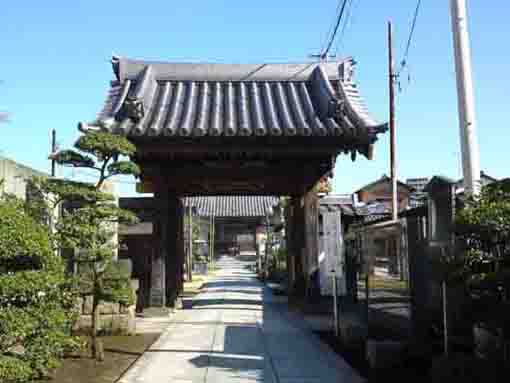
Enmyoin Temple
- 広告 Advertisement -
